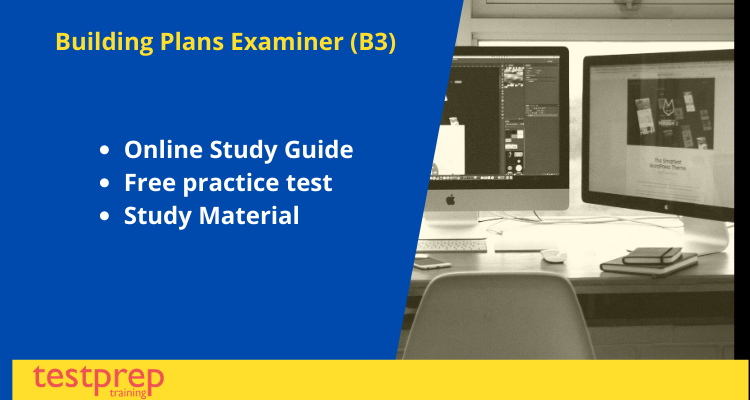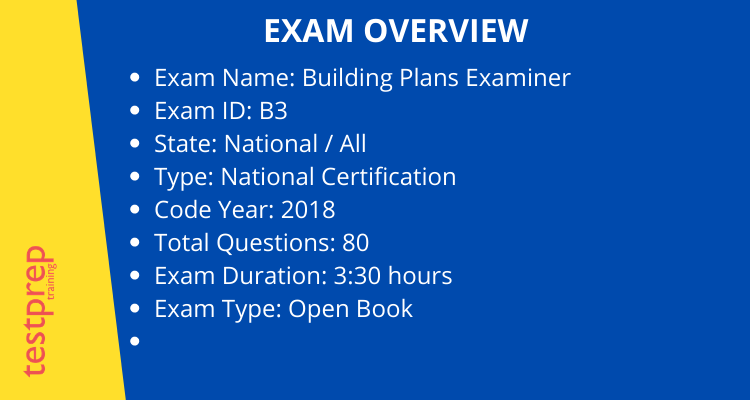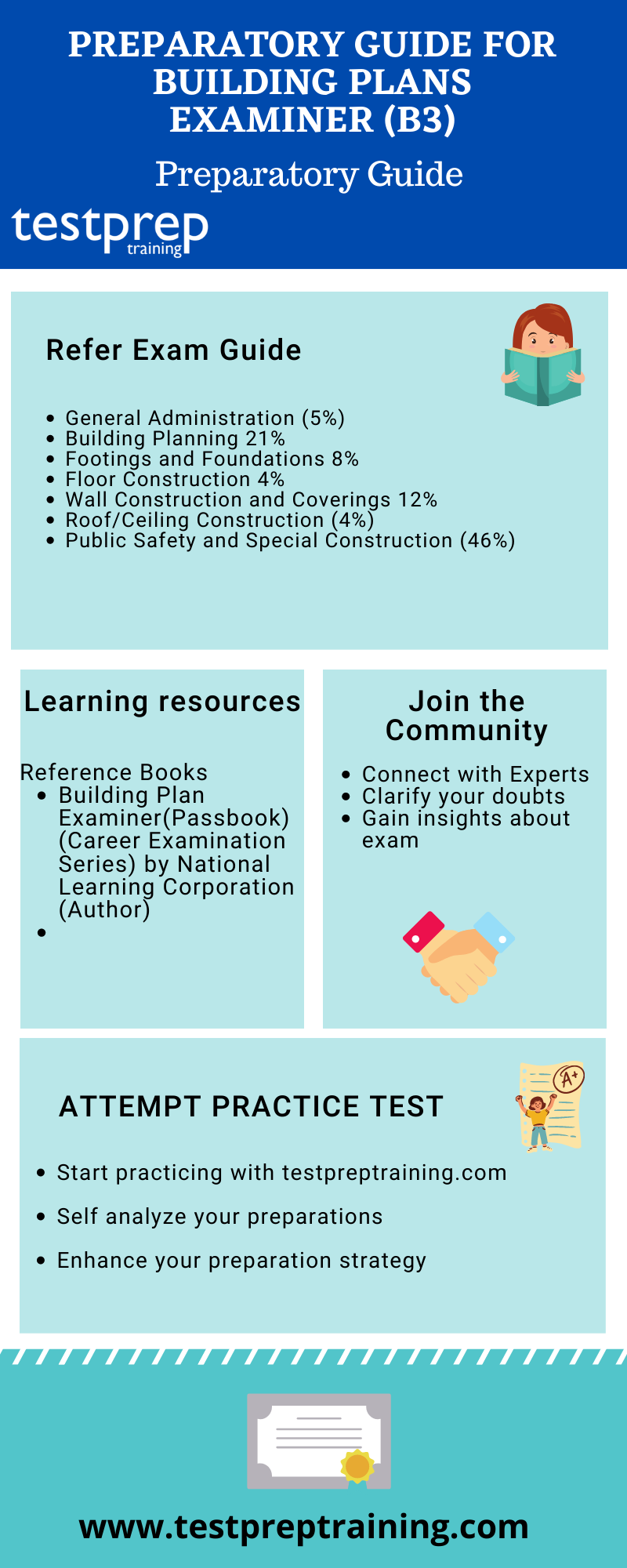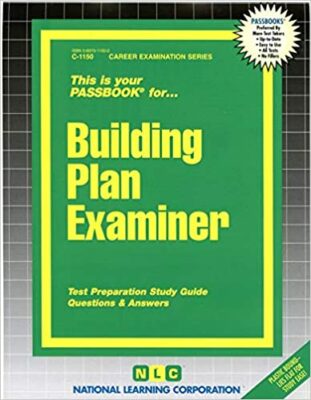Building Plans Examiner (B3)

The ICC Building Plans Examiner (B3) exam is designed to help you develop relevant skills and knowledge for reviewing submitted plans to decide if they meet the requirements of the various Building Codes and Standards adopted by the jurisdiction. Moreover, at this level of certification, as a Building Plans Examiner, you will be able to review plans for any size of the structure in any occupancy classification.
Exam Prerequisite
For appearing for the Building Plans Examiner (B3) certification exam, you are required to 2018 International Building Code and either the ACI 318 OR Concrete Manual (any edition).
Exam Overview
The examination, Building Plans Examiner (B3) having exam ID B3 is an open book examination. Furthermore, for B3 Building Plans Examiner exam questions, there will be a total of 80 questions that have to be completed in the total time span of 3 hours 30 minutes. You need to keep in mind that you need to manage your time accordingly for your best performance. This examination will cost you $219.

Exam Registeration
For registeration yourself for the Building Plans Examiner (B3) examination,follow the following steps:
- Go to the official website of the ICC. Then click on the Building Plans Examiner (B3)
- Next, fill the form and make the complete
- Once you complete your payment and registeration you can appear for the examination.
- Last but not least, Exam purchases are valid for 365 days.
For more information, click on Building Plans Examiner (B3) FAQ.
Course Outline
The Building Plans Examiner (B3) certificatin exam covers the following topics:
General Administration 5%
Project Administration
- Verify that plans, specifications, and other project information is provided and is complete.
- Verify that the project is designed by approved persons when required, and has required approvals.
- Verify that design calculation are submitted in support of structural designs.
- Verify that alternative materials and methods of construction which are not specified by the building code are listed by an approved standard and approved by the building official.
- Verify that estimated project valuations are consistent with industry norms.
Public Information and Legal
- For new and existing structures, answer questions about the need for permits and inspections including special inspections and structural observations, general code compliance of designs, procedures, and materials.
Building Planning 21%
Building Location
- Verify from the site plan that the building or structure location is in compliance with the requirements of the local ordinances, fire separation regulations, fire access, and setbacks.
- Verifies that final grade will provide the required slope away from the footing or foundation wall.
- Verify finish floor elevation in flood-hazard areas for compliance with local and federal requirements.
Allowable Increases
- Verify that allowable height and area increases are based on the open perimeter, and compliance of access to the open space.
- Verify compliance of allowable area modifications for automatic fire suppression and special occupancies.
Use and Occupancy Classification
- Verify that use and occupancy classification, incidental use areas, accessory uses, and mixed occupancies are correct.
Special Detailed Requirements Based on Use and Occupancy
- Verify that special use and occupancy classification is correct.
- Verify compliance of special provisions for atriums, covered mall buildings, high-rise buildings, hazardous occupancies, stages, amusement buildings, and other occupancies or uses.
Type of Construction
- Verify that the type of construction is correct for the type of occupancy.
- Verify that structural members, interior walls, floor/ceiling, and roof/ceiling assemblies, roofs, and stairways conform to type of construction requirements.
Height and Area Design
- Verify the actual height and floor area designs are within the allowable height and floor area limits.
Exterior Walls and Openings
- Verify exterior walls, openings, parapets, and projections conform to the fire-resistive requirements for the type of construction, location on the site, and proximity to other buildings.
Interior Environment
- Verifies compliance of minimum room dimensions and openings. Verify compliance of lighting, ventilation, exhaust, and minimum sanitation systems.
Safeguards During Construction
- Assures that the precautions are taken for the safety at the construction site are specified in the construction documents.
Accessibility
- Verify accessibility of facilities and building elements to physically disabled persons comply with minimum code requirements.
Materials Specifications
- Verify that materials specifications comply with minimum code requirements and listing.
Footings and Foundations 8%
Footing and Foundations
- Verify that necessary reports are submitted of the building site’s soil capacity and stability when required.
- Verify that footings are specified with correct size and setbacks and extend below the frost line.
- Verify that footing and foundation reinforcement meets minimum requirements.
Stepped Footings and Special Foundations
- Verify that stepped footings, piles, piers, and special foundations are correctly specified.
- Verify that wood members are protected against insects and decay.
Foundation Walls
- Verify that foundation stem walls are correctly sized and have sufficient height above grade.
- Verify that foundation wall reinforcement, anchor bolts, and fasteners are correct type, size, spacing, and grade.
- Verify that foundation dampproofing and waterproofing is specified where required.
- Verify maximum unbalanced fill height.
Floor Construction 4%
Floor Systems
- Verify that floor system spans, bearing, and connections comply with minimum code requirements.
- Verify that materials are protected against insects and decay where required.
- Verify that subflooring and decking has required thickness, span, and grade and meets installation specifications.
- Verify compliance of floor design.
- Verify that crawlspaces have required clearance, ventilation, insulation, screening, and access openings.
Concrete Slabs and Floor Systems
- Verify that concrete slabs and floor systems are designed in compliance with standards and material characteristics for specified exposure conditions.
Wall Construction and Coverings 12%
Wood Wall Systems
- Verify compliance of wall systems for proper spans, spacing, bearing, and connections.
- Verify that pre-engineered wall systems are specified in accordance with their listing and manufacturer’s specifications.
- Verify that wood members are protected against insects and decay where required.
Steel Framing Systems
- Verify steel wall system spans, spacing, bearing, and connections.
- Verify that pre-engineered steel wall systems are in accordance with their listing and manufacturer’s specifications.
Masonry Wall Systems
- Verify compliance of masonry grouting, bonding, mortar type, height, size, lintels, reinforcement, and distance between lateral supports for masonry walls.
Concrete Wall Systems
- Verify compliance of height, size, attachments, bracing, and distance between lateral supports, and reinforcement for concrete wall systems.
Exterior Wall Coverings
- Verify that exterior veneers and siding have correct anchorage, support, and backing.
- Verify that a weather-resistant barrier is correctly specified for all walls and around all wall openings.
- Verify that exterior sheathing materials are correctly sized and specified.
- Verify that plaster, stucco, and metal lath have correct thickness and fasteners.
Interior Wall Coverings
- Verify that wall and ceiling coverings are correct type and thickness, are correctly supported and fastened, and meet minimum sanitation requirements.
Roof/Ceiling Construction 4%
Roof/Ceiling Assemblies
- Verify compliance of roof/ceiling construction for span, grade, type, connections, and bearing.
- Verify that trusses are designed in accordance with code requirements and specified in accordance with their listing and manufacturer’s specifications.
- Verify compliance of roof access and roof top structures.
- Verify that roof/ceiling insulation is of allowable materials, and is correctly specified.
- Verify that vapor and moisture barriers are correctly specified.
- Verify ventilation, screens, and access of attic and ceiling area construction.
Roof Coverings
- Verify correct classification of roof coverings, roof slope, installation, flashings, and details, and method of roof drainage.
Public Safety and Special Construction 46%
Means of Egress
- Verify general means of egress requirements, exit access, exits, and exit discharge.
- Verify compliance of public way, public use areas, and the use of public property.
- Verify emergency escape and rescue requirements.
Number, Width, and Arrangements of Exits
- Verify that the occupancy load calculations are correct.
- Verify that the correct number of exits and required egress width are provided.
- Verify that arrangement of exits conform to requirements for separation, travel distances, and intervening rooms.
- Verify compliance of corridor arrangement and dead ends.
Exit Stairways and Ramps
- Verify that stairways and ramps have correct width, rise, run, slope, landings, headroom, and height.
- Verify correct escape illumination, signage, handrails, guards, and other requirements.
Exit Doors and Egress Windows
- Verify that exit doors have the correct direction of swing, size, and type of hardware.
- Verify that windows intended for use as emergency egress have correct clear opening areas, width, and heights.
- Verify that exit doors have the correct direction of swing, size, and type of hardware.
- Verify that windows intended for use as emergency egress have correct clear opening areas, width, and heights. Protected Exitways
- Verify that corridors, exit passageways, stairway enclosures, horizontal exits, exit balconies, and exit courts are provided where required and have the correct fire protection.
Special Exiting
- Verify correct number and width of aisles and correct seat spacing.
- Verify requirements for grandstands, bleachers, and specific occupancies and uses.
Fire Alarm and Extinguishing Systems
- Determine when fire alarm, sprinkler, and standpipe systems are required; verify compliance of fire suppression systems.
Area and Occupancy Separations
- Verify that area separation and occupancy separation walls and floor/ceiling assemblies are located where required and have correct fire-resistance.
Fire-Resistive Construction
- Verify that the materials used for structural members, walls, floor/ceiling, and roof/ceiling assemblies and shaft enclosures comply with requirements for fire-resistive protection.
- Verify that fire-resistance-rated construction and location is in compliance with the code and tested assembly requirements.
Heat and Smoke
- Verify that heat, smoke detection, smoke barriers, and control systems are provided where required and are correctly powered and listed.
- Verify that curtain boards and smoke and heat vents are correctly specified.
Interior Finishes
- Verify that interior finishes meet required flame-spread and smoke-developed classifications based on location, use and occupancy classifications, and are correctly supported.
Safety Glazing
- Verify that safety glazing is specified where required.
Opening Protectives, Penetrations, and Joint Systems
- Verify compliance of opening protectives, penetrations, and joint systems in fire rated assemblies.
- Verify that fire blocking and draft stopping is specified where required.
Miscellaneous Construction
- Verify that exterior stairs, ramps, porches, decks, and balconies which are open to the weather support designed loads; are of suitable materials; and have required slope and width, tread, riser, headroom, guards, and handrail dimensions.
Building Services and Special Construction
- Verify compliance of existing structures, membrane structures, temporary structures, pedestrian walkways, tunnels, awnings and canopies, marquees, signs, towers, antennas, elevators, and conveyance systems.
- Verify seismic restraint, high-wind, and snow-load design requirements.
- Verify that elevator lobbies, cars, and hoistways are correctly specified.
- Verify that elevator shafts are properly vented.
Fireplaces and Chimneys
- Verify that fireplaces, flues, and chimneys are correctly designed and have required clearances from combustible construction.
Preparatory guide for Building Plans Examiner (B3)
To crack any examination you need to have a proper plan and study guide. There is an endless list of resources that you can use for exam preparation. For acing the Building Plans Examiner (B3) you need to prepare, practice, and work hard. To help you out, we have provided all of the required material and information along with B3 Building Plans Examiner study guide here:

Refer the Exam Guide
To clear any examination it is very important to know the course content and outline. The ICC Building Plans Examiner (B3) has the following modules which you should prepare and practice:
- General Administration (5%)
- Building Planning 21%
- Footings and Foundations 8%
- Floor Construction 4%
- Wall Construction and Coverings 12%
- Roof/Ceiling Construction (4%)
- Public Safety and Special Construction (46%)
Learning Resources
It is very important to prepare with the right resources. To clear any examination all you need to work hard but efficiently and in a smart manner. To help you out we have provided learning resources for Building Plans Examiner certification.
Reference Books

Books are an essential part of the preparation, searching for the right study material has always been a difficult and tedious task. There is an ample number of books available for Building Plans Examiner (B3) are:
- Building Plan Examiner(Passbooks) (Career Examination Series) by National Learning Corporation (Author)
Join Study Groups
Joining study groups is a good way to get yourself fully involved with the certification exam you apply for. Furthermore, these groups will help you get up to date with the latest changes or any update happening exam. Also, these groups contain both beginners as well as professionals. You can ask any query related to the exam or you can talk about the exam without any hesitation. Moreover, here you can start any discussion about the issue related to the exam or any query. By doing so, you will get the best possible answer to your query.
Start Practicing with Testpreptraining
Practice makes a man perfect. Practice will actually help you identify the aspects of your preparation you need to work upon. After completing your preparation you should be taking sample papers and practice tests. B3 Building Plans Examiner practice tests will help you with self-assessment and bring out a confident person in you on the day of the exam. The evolution of practice tests has done nothing but added more to its generosity. They are considered as one of the most efficient sources to study for the exam. Therefore, it is highly advised to perform more and more B3 Building Plans Examiner practice test. Start using B3 Building Planner Examiner Sample Questions Now!

